Earth Mortars
Tom Morton, Nigel Copsey and Rebecca Little
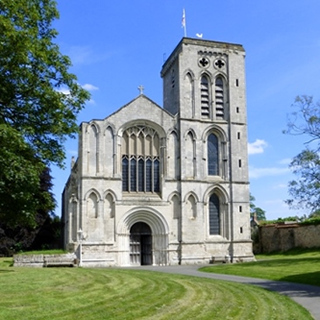 |
|
| St Mary’s Priory Church, Old Malton, Yorkshire (Photo: Nicholas Fletcher) and, below, earth mortars visible in its 12th-century vaults (Photo: Nigel Copsey) |
In recent years, increasing recognition of the prevalence and importance of earth mortars in traditional construction has informed the development of appropriate techniques for the repair of ruined and standing structures. Churches form an important part of this heritage. Most medieval churches were constructed using earth mortars, with use declining through the 18th and 19th centuries.
From prehistory until the 19th century, earth was used in a variety of ways to construct buildings of every type across Britain and Ireland, as it was in virtually every culture and climate. The ubiquity of earth as a construction material was due to its wide availability at low cost and the ease with which it can be worked into a range of materials to construct durable buildings.
Traditional earth mortars could be very varied in quality, reflecting local subsoil geology. Some vernacular buildings have mortars of natural earth which has very poor technical qualities, while other earth mortars are either naturally robust or have been altered to enhance their qualities. In this context, churches, like other high-status buildings, tend to present mortars of higher quality.
The conservation community is only now beginning to recognise the extent to which earth mortars were traditionally used. However, a number of organisations including Historic England, Historic Environment Scotland and Earth Building UK & Ireland, are working to better document them.
TYPICAL PERFORMANCE
Earth mortars were typically used as the bulk mortar to construct the wall, with the face pointed or rendered in lime to create a more durable external finish. Thus, earth mortars are typically only recognised when building fabric deteriorates or during alterations. As churches tend to be well-maintained and rarely altered, it can be expected that many churches contain unrecorded earth mortars. Increasing awareness of the distribution of these mortars and their characteristic performance should foster a better assessment of standing structures and inform appropriate repairs.
While earth mortars typically sit happily hidden within a wall in their original state, this can change and significantly affect the condition of the structure in ways that are different from lime mortars.
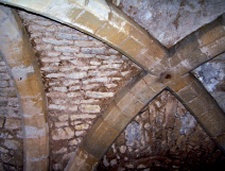 |
Earth mortars typically have good compressive strength, but negligible tensile strength. If a structure is subject to movement, for example through settlement of foundations, changes in load patterns or the decay of timber elements, earth mortars provide little restraint and movement will tend to be more directly apparent than in lime-mortared masonry. This is also true for the cohesion through a wall, where earth-mortared cores provide little restraint to the separation of masonry faces subjected to stress where there is poor stone-to-stone bonding.
The quality of the masonry build becomes more important to the strength of the wall where it relies less on the binding strength of its mortar. So local and pronounced movement of masonry can be an indicator that earth mortar is present and it is important to confirm this to understand how a wall is failing and might best be repaired.
The other key characteristic of earth mortars is vulnerability to moisture. In a well-maintained building, earth mortars perform well in buffering moisture and the hygroscopic properties of clay assist in preserving timber elements and decorative finishes from decay. The ability of earth mortars to move moisture assists in the detection and analysis of damp within buildings.
Earth mortars can be significantly affected if moisture levels in a wall are raised. Typically this is by water ingress due to failure of rainwater goods or because of barriers to moisture movement formed by the application of cementitious pointing or coatings. If enough moisture builds up within an earth-mortared wall, its moisture content will increase and its strength will decline until the material returns to a plastic state. Ultimately it will flow out of the wall, leaving in effect a dry-stone structure.
This extreme is rare, and it is usually only found in ruined structures, which are subjected to a much more aggressive range of decay mechanisms than churches in use. However, moisture levels in earth mortars can be used as an indicator of damp in a structure, prompting the need to investigate defects in roofs, drainage and finishes, and to resolve them before they develop further. The presence of salts on the surface of earth mortars is another clear indicator of significant moisture movement within a wall.
EARTH MORTAR MATERIALS
Typically, earth mortars are made from local natural subsoil, where clay minerals act as the binder to sand and silt particles. Topsoils, which contain organic matter, are unstable and are never used. Long-term weathering research published by Historic Environment Scotland in 2015 found that the key factor in the performance of a mortar is particle size distribution. If an earth mortar is well graded (that is to say, containing a good range of particle sizes, not just fine particles) it will have good working qualities and prove resilient; if poorly graded it will always be vulnerable to progressive decay.
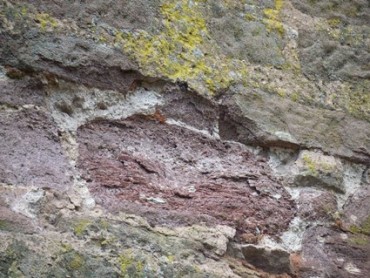 |
|
| A typical example of cement repointing over original lime pointing over earth building mortar (Photo: Tom Morton) |
The grading of natural subsoils varies considerably, but much of the UK has soils that can be used. A range of simple field and laboratory tests can determine the key characteristics. Poorly graded natural subsoils can be enhanced, typically by the addition of sand to reduce the clay proportion, although so far there is little evidence to indicate the degree to which natural soils were enhanced in this way.
Grading influences shrinkage as well as durability, and this is an important factor in repairs. Earth mortars become workable through the addition of water bringing them into a plastic state, and they gain strength as the material dries. Well-graded mortars will have low levels of shrinkage, good cohesion and bond.
Clay/lime composite mortars
There is considerable evidence for historic mortars that contain both clay and lime minerals as binders, and these composites include a variety of materials and applications. There are weak lime mortars that used unwashed sand with some clay content – these are thought have been commonly used as cheap mortars for boundary walls and low-status structures. There are also earth mortars where the soil is naturally calcareous. In both cases, the mixture of clay and lime was incidental rather than intentional.
However, there is also clear evidence for the widespread historic use of earth mortars where a small proportion of quicklime was added to enhance performance. Where the proportion of lime is relatively small, it can be more useful to consider the mortar as a ‘stabilised’ earth mortar rather than as a weak lime mortar, although with any inclusion of lime the performance starts to change. Such mixes are the subject of current research by the Building Limes Forum Ireland and others, and the knowledge base will undoubtedly increase in coming years.
In such mortars, volumes of quicklime were added to earth, typically at ten per cent by analysis, indicating the routine addition of around five per cent quicklime, which will have doubled in volume upon slaking. By the 17th century, if not before, this had become the norm for building mortars in some areas across the UK. For solid masonry, the quicklime was fairly loosely mixed and streaks of slaked lime or a multitude of angular lime lumps within the mortar make the addition of quicklime quite obvious, which is not always the case with lime-stabilised earth plasters.
REPAIR TECHNIQUES
The likely presence of earth mortars in the fabric of a large proportion – perhaps most – medieval churches and, indeed, most masonry structures built before 1800 across the UK and Ireland demands particular attention to detail. Many will have been repointed in the past with incompatible cementitious mortars, which have been observed to cause serious problems for earth-built structures, as can the harder-setting modern natural hydraulic lime (NHL) mortars.
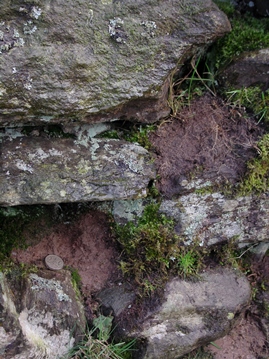 |
| Earth mortars were used to stabilise the 7th-century ruins of Kilmichael Chapel, Isle of Bute. (Photo: Tom Morton) |
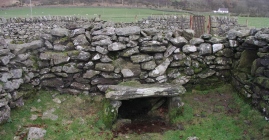 |
Earth mortars demand high breathability in any surface treatments and hot-mixed air lime mortars and renders offer this breathability. (In a ‘hot mix’, quicklime is mixed with the aggregate before being slaked: it is believed that the steam generated in the process leads to a better pore structure than a mortar made with lime putty.) Earth-mortared masonry structures that have become unduly wet after repointing with either Portland cement or strong NHL mortars dry rapidly and effectively once repointed with hot-mixed air lime mortars. The dry fabric is more thermally efficient, less vulnerable to either salt or frost attack and generally more healthy.
Repairs in earth mortar generally follow the same principles and techniques of good masonry work as lime mortar repairs, although the material has important differences. Not least of these differences is the much lower level of health and safety risk, without the caustic, heat and chemical aspects of lime.
Consolidation and initial deep pointing will ideally be executed in an earth mortar that contains the minimum moisture needed to allow it to be applied in a plastic state, in order to minimise shrinkage and reduce the time before pointing can be applied. Some residual moisture in the clay core can be a benefit in reducing the risk of shallow lime pointing drying out before curing properly.
APPROPRIATE REPAIR MORTARS
Ideally, repair mortars will be similar in character, appearance and performance to the original material of construction. There are circumstances where it is desirable to alter the mortar to enhance its performance, but this is usually only on church ruins, where the masonry element is significantly more exposed to moisture than it would have originally been.
In any event, the starting point is to understand the original mortar. Its character and the presence or otherwise of lime addition should first be established by visual inspection, by simple field tests and, if still in doubt, by laboratory analysis.
Local subsoil will almost certainly be the material used originally and it will therefore also make the most appropriate material to use in repairs. However, despite their abundance, local subsoils can frequently prove remarkably difficult to source. This is the most significant obstacle and time needs to be allowed at the appropriate stage in a project for this task. Soils can vary within a relatively short distance and drift geology maps can assist local knowledge on these days spent peering in ditches and courting busy groundworks contractors.
Pre-mixed earth mortars are available, but generally at exorbitant cost. It is also possible to tailor-mix earth mortars using bulk clay and sand materials and this often proves most cost-effective and time-efficient. However, both these approaches reduce the authenticity of the repair material. The physical performance is likely to be different, as is the visual appearance. Nevertheless, a non-local earth mortar will always be preferable to a lime mortar, and cement should never be used.
If quicklime is evident in the original, the new earth mortar should be mixed to a sloppy consistency, with a water-content just slightly above the liquid limit of the earth, before adding quicklime, as this will enable the clays to engage with the lime most effectively. The addition of five per cent quicklime powder will bring the mortar back below the liquid limit and enhance workability.
Where a locally sourced earth is poorly graded, it can generally be improved by the addition of sand (both sharp and fine) as necessary to reduce the clay proportion. Other additives can be included to manipulate the performance of the mortar in special situations, but these are rare and should be approached with caution. Good grading goes a long way to ensuring good performance.
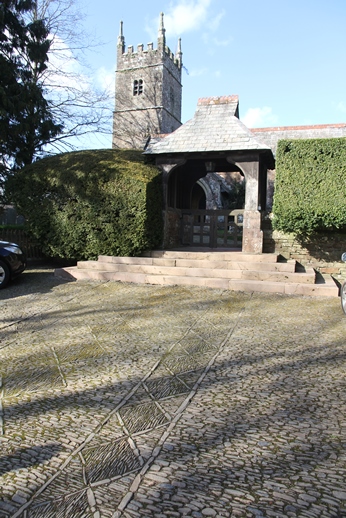 |
| Earth-bound cobbles at St James the Less, Huish, Devon: earth mortars have been used widely as a bedding for stone paths due to their ability to accommodate movement and shed water. (Photo: Jo Cox, Keystone) |
Pointing earth-mortared masonry
Whether earth or air lime mortar is used for repair, the masonry should be repointed with a hot-mixed air lime mortar. Hot-mixed air lime mortars may be considered generally compatible with earth mortars, offering suitable breathability, compressive and flexural strengths as well as appropriate durability and excellent workability – masons find them a joy to use, as, indeed, are earth mortars themselves.
In exposed or unusually damp locations, this might be gauged with pulverised brick (dust and chips), Argical (formerly Metastar, calcined china clay), or other pozzolanic additives to enhance durability as well as to give an initial set within exceptionally damp masonry. It has been common in Scotland to gauge hot-mixed air lime mortars with NHL, typically 1: 1: 6 – one part quicklime to one part NHL 2.0 and six parts aggregate. This has generally been successful over the past 20 years.
The use of NHLs as the sole binder should generally be discouraged in the treatment of earth-built masonry structures. Putty lime mortars may be appropriate but modern putty lime, made as it has been made over the past 40 years, has minimal historic precedent and the consensus of historic texts on lime is that such putty lime delivers a weak mortar, significantly less durable and somewhat less breathable than a hot-mixed air lime mortar. Putty lime mortars should only generally be used when a particularly sacrificial mortar is considered of paramount importance and in the expectation of limited durability.
Ruined masonry
‘Ruined’ masonry requires a more complex analysis and response than complete churches. As the movement of moisture is often more significant, protective lime finishes may have been lost and the masonry can be subject to stresses that were not intended and may not be readily apparent.
In ruinous church structures, earth mortars tend to sacrificially decay while the stones remain, and the remnants of earth mortars have often been overlooked or misidentified as soil or depleted lime mortars. On archaeological sites where masonry is buried, earth mortar often survives well, but has commonly been mistaken for accumulated earth.
OTHER APPLICATIONS
Earth was a cheap, user-friendly material with many applications beyond its use as a mortar in masonry. Earth plasters are also quite common, but tend to be poorly recognised as they are typically finished with a lime plaster top-coat or decorative finishes. Earth was also used as deafening in floors, for internal partitions and to form floors.
Historic England is currently working on the publication of a detailed study of Devon cobbled churchyard paths which highlights the practice of using earth mortar as a bedding for stone paths. Devon has an abundance of clay soil and the report will discuss the performance of mortar bedding in relation to surface water drainage and durability. The study illustrates how the traditional knowledge of local materials science informed historic earth construction practices: the conservation community is now working to recover this knowledge to inform appropriate repairs.
SO, BE PREPARED
In summary, the presence of earth mortars within the masonry fabric of medieval and later churches across most of the UK should be assumed and then investigated prior to any programme of repair and conservation. Repair mortars should then be designed to be like-for-like and compatible, with time taken to source an appropriate earth material.
While earth mortars may be unfamiliar to owners, consultants and contractors, it is almost always possible to achieve sound repairs using earth mortar, as with any other historic material, and the same conservation ethic and approach should be applied. This is a field where expert advice is available and there is an ongoing body of documentation of site reports, skills training and technical research to inform good practice.
~~~
Further Information
English Heritage, Practical Building Conservation: Earth, Brick & Terracotta, Ashgate, Farnham, 2015
T Morton and R Little, Earth Structures, Renders & Plasters Project Vol 2, Historic Scotland Research Report, Edinburgh 2015
T Morton, Earth Masonry: Design & Construction Guidelines, BRE Press, Bracknell, 2008
B Walker et al, Earth Structures and Construction in Scotland, Historic Scotland Technical Advice Note 6, Edinburgh, 1996



